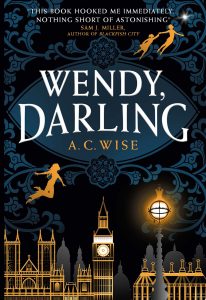WENDY, DARLING by A. C. Wise (BOOK REVIEW)
“Anger became her habit, Neverland her defense.”
The story of Peter Pan and Wendy is a classic that originated from the play Peter Pan, The Boy Who Wouldn’t Grow Up by Scottish Playwright J.M. Barrie, who is said to have written about the character of Peter (most likely) based on his older brother David, who died in an ice-skating accident the day before his 14th birthday. The play premiered in 1904 followed by the first written edition of that story as Peter and Wendy in 1911.
I grew up loving Disney’s Peter Pan in form of the movie from 1953 as well as the book with all the other familiar characters and illustrations that hold a place with me as one of my most vivid memories and stories I grew up with among a few others. This may explain my curiosity for retellings and/or alternate endings of long loved classics today. Anything about Peter Pan’s character and Neverland is something I’m happy to read and experience.
 Wendy, Darling is unlike any other Peter Pan story I have ever read or heard of. It isn’t a retelling nor is it is a continuation, alternate ending or prequel to the original, but one that is wedged in the timeline after Wendy returns from Neverland and the popular movie Hook. It reveals some treacherous dark times for Wendy and grim twists and secrets of Neverland never explored before.
Wendy, Darling is unlike any other Peter Pan story I have ever read or heard of. It isn’t a retelling nor is it is a continuation, alternate ending or prequel to the original, but one that is wedged in the timeline after Wendy returns from Neverland and the popular movie Hook. It reveals some treacherous dark times for Wendy and grim twists and secrets of Neverland never explored before.
This story is told alternately between two pov’s, Wendy and her daughter Jane and it begins with adult Wendy witnessing her daughter Jane being taken by Peter from her bed one night while she watches everything unfold helplessly and unable to follow Peter and Jane into the night sky. From here, it proceeds to split up the experiences of the characters and adding another timeline for Wendy about her past and experiences in Neverland.
While young Jane meets the lost boys in Neverland, she experiences the strange amnesia, as all the lost boys are unable to remember her name. Peter introduces her as the new mother and she is expected to pick up the pieces that mothers always have done such as cooking for the boys, telling them stories, and mending their wounds and little hearts from make-believe combat. Jane has an idea that something isn’t right but can’t put her finger on what exactly it is. She takes initiative to walk beyond the places on the island no lost boy is supposed to venture, and discovers some terribly dark things she cannot explain or understand.
In the meantime, Wendy’s pov talks about her time after her return from Neverland and how all the adults never believed any of her stories and ridiculed her delusional. She is forced to move into a sanatorium for the insane in which she spends a few, horrible years.
“Tears roll silently down Wendy’s cheeks as the razor scrapes across her scalp. Shame fills her; it’s a vain thing to cry over.”
Instances like these are told over the greater part of the novel and it makes for a rather tragically sad story versus one of adventure and happiness. Wendy’s feelings and memories are explored vastly into dark depths, from cruel methods at the sanatorium to friendships, her relationship to her brothers, losing her parents and then finding herself afterwards in an arranged marriage.
“Loving something means having something to lose. It’s the truth Wendy has known since she lost Neverland, since Michael went to war and came home with ghosts in his eyes, since their parents boarded a ship doomed to sink.”
When Wendy’s and Jane’s storyline finally close in on Neverland, the focus shifts to the mysteries now found on the island. As mother and daughter find their way towards each other, Wendy slowly realizes all the things that are wrong with Neverland and together with Tiger Lily, heads into the darkness to save Jane from evil within.
“Nothing can die in Neverland. Peter told her so. But here is the skull, incontrovertible, her own truth against Peter’s, and she’s done taking other peoples word for how the world functions. “
“Ghosts. The word comes unbidden. Neverland was never haunted before, but there was never death here either. “
This certainly made for the most interesting part of the novel. I had not thought in such dark terms towards Neverland and its inhabitants, but it is a great idea explored and utilized by the author in this novel. Upon talking this over with someone who has not read Wendy, Darling yet but is an equal fan of Peter Pan, brainstorming ensued and either I gave a fantastic recap, or, the more likely and accurate scenario is, that these new story elements were invented with careful intent and wedged into all the existing parts we know from previous Peter Pan versions/stories today.
Though I feel the novel suffered under so much tragedy of Wendy’s timeline and a lack of happy adventures, the character explorations and family circumstances around her are worthwhile to learn about. With some new revelations towards the novel’s end about Peter and the island, I am thinking of rewatching the movies Peter Pan and Hook to mesh up my newly gained knowledge from C. S. Wise’s Wendy, Darling to foreshadow in parts these new ideas if possible.
If this has left your curious, check out this island story with a new, darker take.
Happy Reading!


